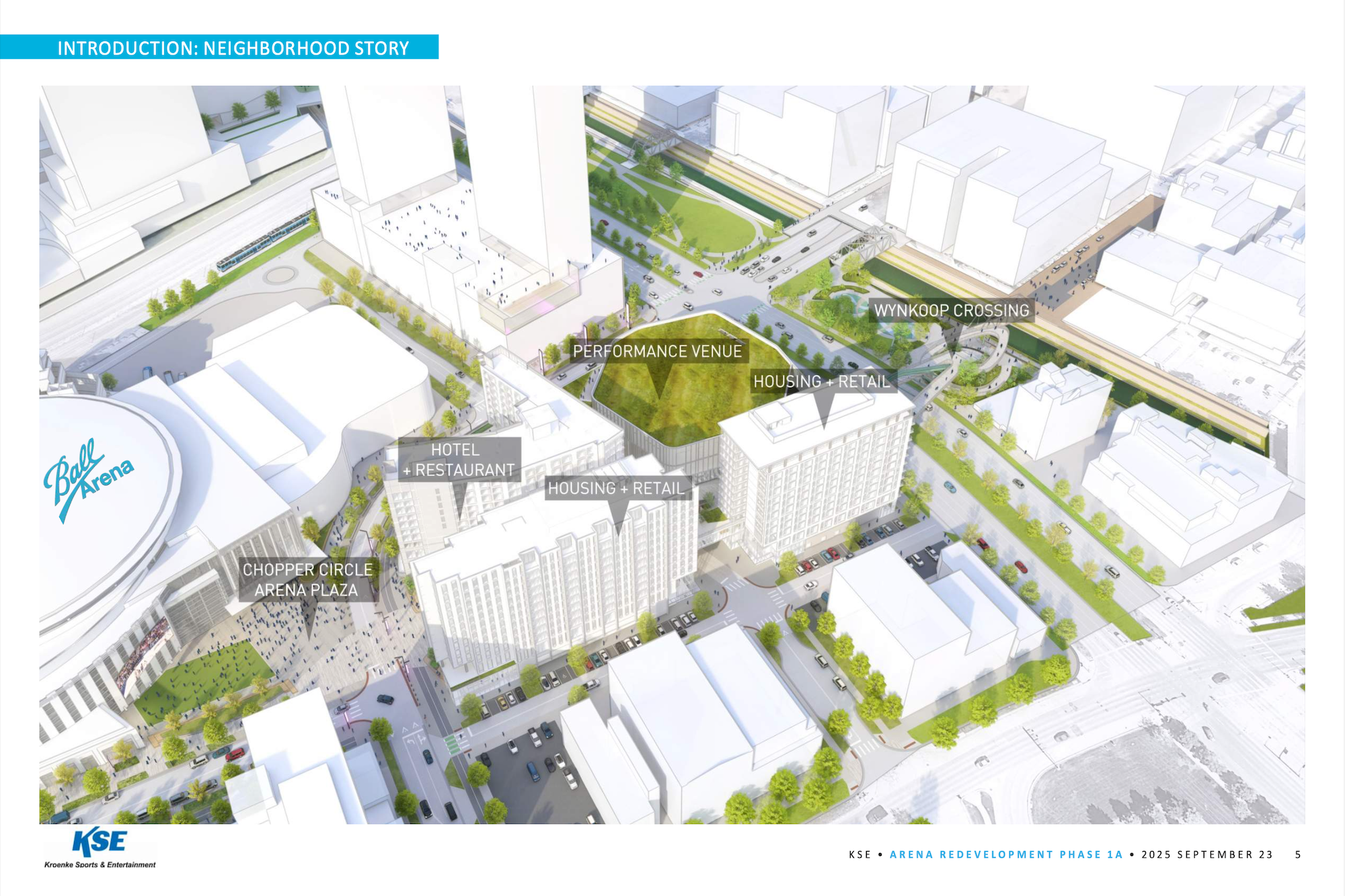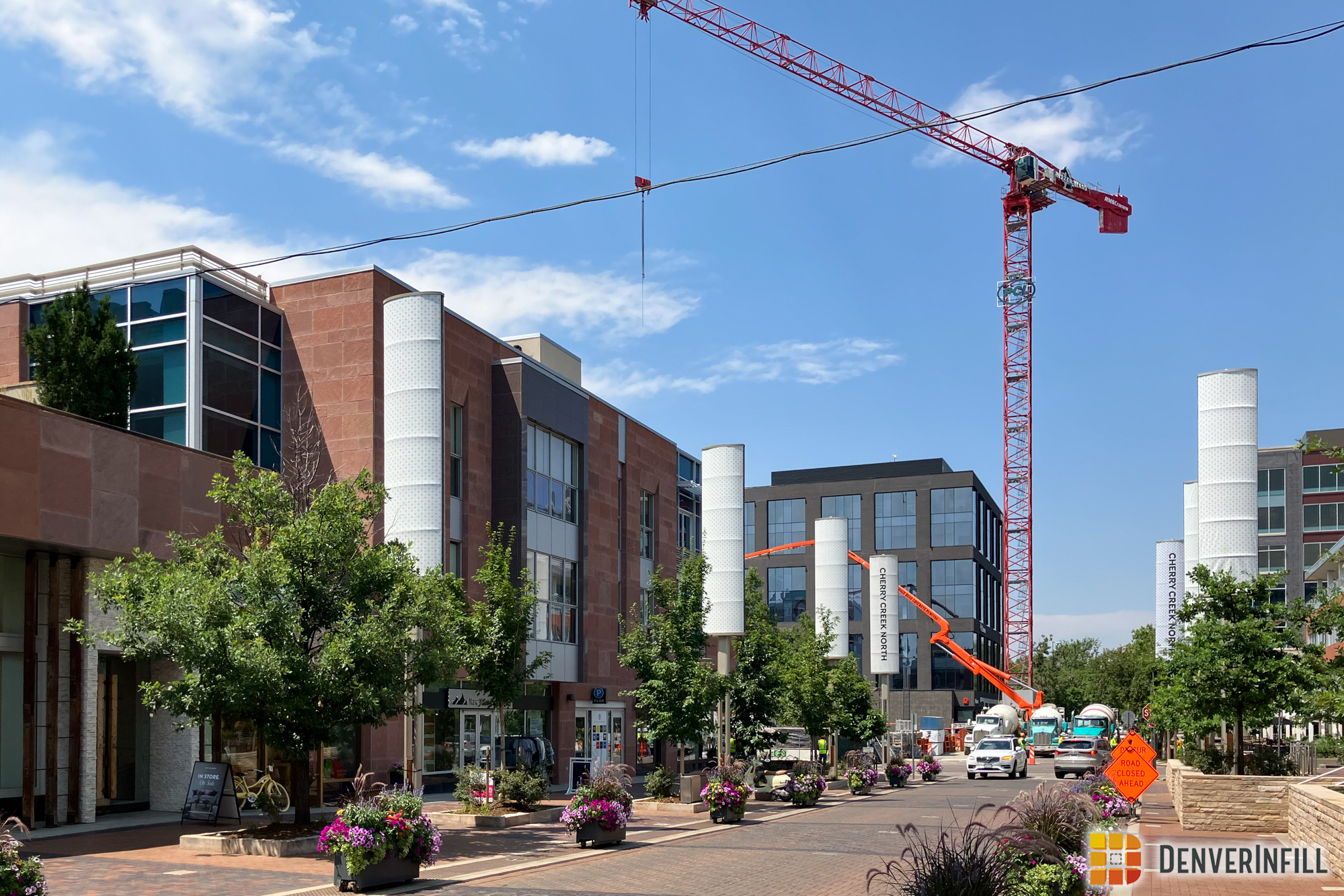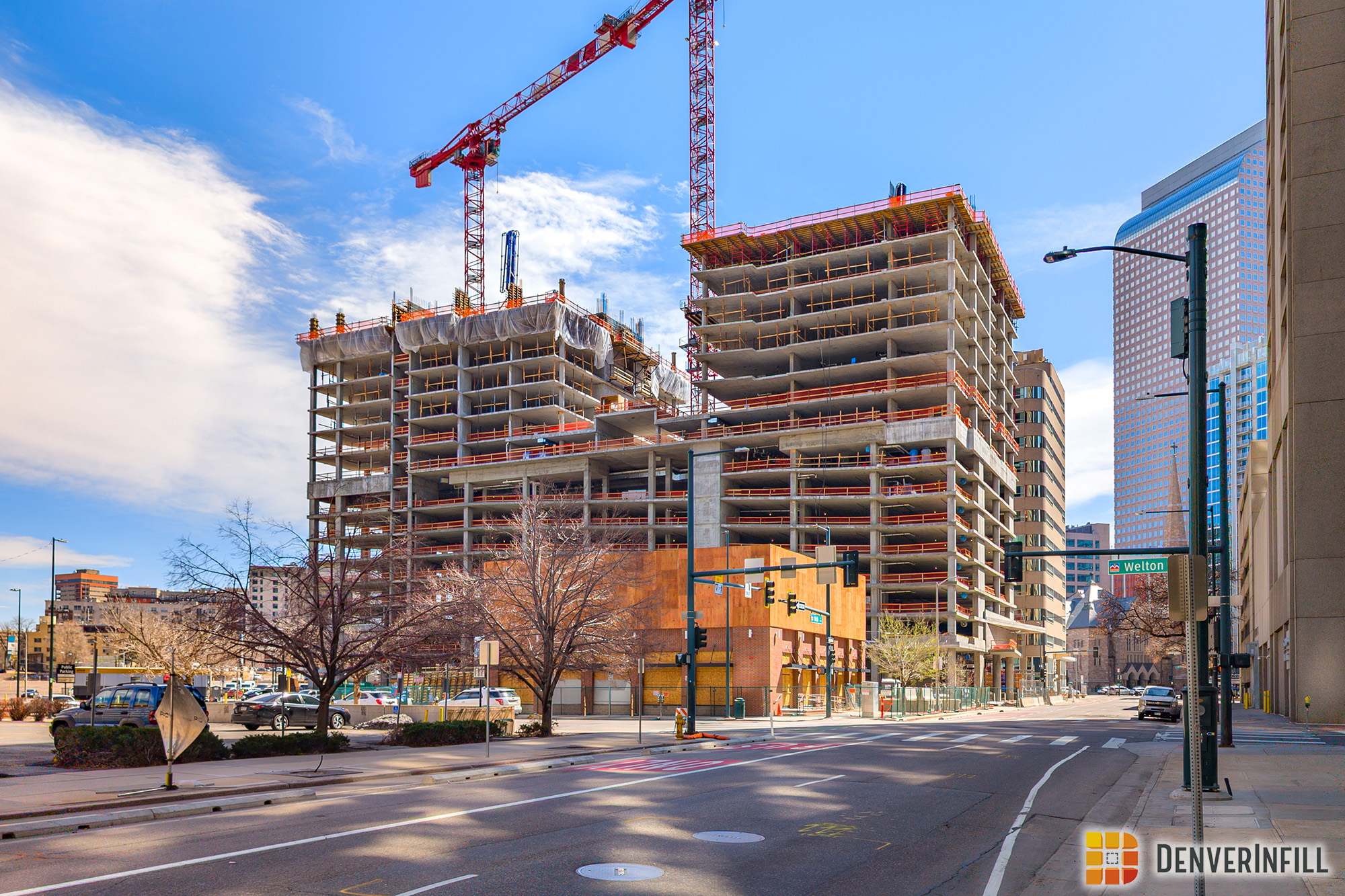Denver’s new skyscraper in the making has reached another milestone. The concrete parking structure for 1144 Fifteenth has topped out and steel, for the first floor of offices, is starting to go up!
As of today, four steel beams have started framing the 13th floor. If you are having a hard time seeing it, the steel beams are on the left side of the first photo.
Heading to the street level, we can see that the glass facade is quickly progressing on the northwest side of the tower.
As a bonus, here is a photo taken by one of our awesome DenverInfill readers.
Steel structure almost always rises faster than concrete, so we should see brisk vertical progress moving forward. How exciting!
















Can I be depressed that almost half this building is car storage? Ugh.
It’s not. So no.
Twelve floors of parking and twenty-six of office. Missed it by one floor, my bad. Can I be depressed that 46% of this building is car storage? Ugh.
Your math is a little off. 12 floors is 32% of the 38 total floors, so just under a third of the building is parking. But the answer is yes, you can be depressed that a third of one of the most prominent projects in Denver since the 80’s is dedicated to parking.
Your math is still wrong.
12+26 = 38
12/38*100 = 31.6%.
I can only assume that your weren’t counting the ground floor/lobby/community spaces, which I think also are mixed with some parking. However, that still is a lot of car storage.
Good catch. The first floor should not be included in the parking. So that would be 29% car storage. That’s a bit better.
I’ll take the extra height in the skyline, especially for a building with such an exceptional design which can help bring our skyline out of the doldrums.
40 stories, 10 of which are parking.. Where do you expect all the people who work in this building to park? I get the whole utopian ‘everyone should ride a bike or take the train’ argument, but what if I want to live in the suburbs? What if I want to go to the grocery store or driving range after work? People are allowed those conveniences, and until self driving on-demand vehicles are replete, we need to offer buildings with the modern convenience of parking.
Question I have – is as downtown Denver gets denser and we have more parking like we have here, do we want Denver to take down buildings to expand roadways to allow all those cars the convenience of getting to work when there are better ways of doing it? I continue to hope we reduce lanes heading into downtown for a more pedestrian oriented city instead of the the car.
Never a good sight. Especially given its proximity to light rail.
Only about a third is parking, and with the glass facade you won’t be able to tell.
It’s going to be great to see the real part of the building start going up instead of the car storage facility.
Seems different from the 3 tallest in Denver. I’ve parked at the Cash Register building in the garage across the street. They don’t have floors of parking in the building… unless they have a lot of underground parking?
Anyway, happy to see this really start to rise.
This is a direct result of the FAA height limit imposed over downtown Denver during the 1980s skyscraper boom, in which downtown’s close proximity and direct line-of-sight to the runway vectors at Stapleton Airport translated into all of our “big three” (Republic Plaza, Wells Fargo, 1801 California) maxing out their vertical envelopes. All three buildings are the *exact same* geographic height in the skyline. While there is a 16′ spread in structural height among our three tallest, this is a function of variances in terrain elevation.
To maximize leasable office space while capped by a height limit, the buildings located their parking facilities in a separate/adjacent/adjoining structure next to the building.
Nice piece of trivia! I did not know that. Thanks!
Google the renderings and scale model of this building. Once the glass facade is in place you will have no idea how many floors are parking and you won’t really care. This will be the coolest looking building in all of downtown Denver.
It will be the best behind Tabor and Davita.
You’re right that the parking won’t have a negative visual impact on the building, but there are other factors beyond aesthetics. More parking means more traffic and less pedestrian friendly streets. Obviously, in a city like Denver, we can’t get away with no parking, but a stronger emphasis on public transit and alternative transportation would help to mitigate the traffic issues that come with new development.
Less traffic and less cars would be great in producing a more pedestrian-oriented city, that said I feel as though developers are going by demand (just a hunch). As such, in Denver there is still a great demand for parking and there are a ton of people commuting into downtown every day, currently without the abundance of public transit options that other big cities have to offer.
Again, this is just a hunch/opinion… Personally I think the hate for copious amounts of parking in buildings – especially when it’s hidden from sight – is just ridiculous. If the street-level activity increases, who cares if in-building parking increases?
I wish they would put the parking underground. But I’m not an architect or geologist, so I can’t say whether that was feasible. Seems like a more expensive proposition to go up with parking.
Quite the contrary. Underground parking is exponentially more expensive than above ground parking.
Excavation is expensive. The geotechnical and structural (foundation) issues become more and more complicated the further down you go.
It’s actually far more expensive to go underground with parking.
Placing parking below grade is nearly 2-3 times more expensive than building a structure above grade, it is the number one driver for why parking goes above grade. The only reason developers will build below grade is because of height limits and trying to maximize leasable space.
As for the amount of parking, that is usually driven by the potential tenant and their parking ratio requirement (2.5/1000 sq ft., 5/1000 sq. ft., etc.). If the developers had their way, I’m sure they would love to build zero parking on everything, because parking garages are expensive, a maintenance nightmare, and have a horrible rate of return compared to leaseable space. Having too little parking can sometimes hurt the developer in being able to lease the office space, especially to more traditional commercial tenants like O&G. Denver developers still have quite the uphill battle trying to convince downtown tenants to lower their required parking ratios because the public transit options still are pretty limited.
To be clear, the above-grade parking is completly cladded in glass. The intent of this design is that it appears as a singular facade from grade to the crown. When complete, the facade will look like one continuous curtainwall system. This design is very costly, but makes for a totally concealed parking garage. So, in this case, the above-grade parking is nearing the $/stall of below-grade. Denver has never seen quality architecture to conceal parking. And yes, the market demands the parking ratio as designed. You develop to the market demand. And, the site is restricted to an FAR of 17:1 which is driving the macimum GFA density for this specific site.
I love urbanism just as much as the next guy, but I’ve never been able to get on board with being against parking for the sake of being against parking. As long as its underground, or incorporated into dense development, the more the merrier. I guess I’m a bad little urbanist.
How does more parking make for more traffic and less pedestrian-friendly streets? You either have enough parking for the people that choose to drive there or you don’t. And if you don’t, then people will be forced to drive around looking for a parking spot – and that would increase traffic.
Or perhaps the idea is to punish people for driving? It’s what they do in San Francisco and it’s asinine. They literally artificially limit the number of parking spaces that exist within The City with the intention of making it so hard to park a car that mass transit looks more appealing in comparison. The result is that The City is less accessible in general which has a negative impact on the economy.
To make alternative modes of transportation more appealing by sabotaging the main mode (and only mode for most people since the vast majority of Denver Metro residents don’t happen to live within walking distance of the CBD or a rail stop) would only make the CBD less accessible in general. If you want to make an alternative mode more appealing, then improve the alternative mode.
I don’t even live that far from downtown (I’m about a half block west of City Park), but when I need to get downtown in a timely manner, I drive. That’s because there’s no rail line that comes out here, so if I wanted to take public transportation I would be forced to take the 15. And riding a bike has never been an option for me because I don’t like to get to places all sweaty and I wouldn’t be able to afford to replace my bike every time it gets stolen. If Denver’s public transportation infrastructure was improved, and a nice rail line connected my neighborhood to downtown, I would take the rail every time and would probably even consider getting rid of my car altogether (I’ve always loved living without a car in an urban area after all). OTOH, if some genius turned 17th and 18th Avenues into bogged-down two-way streets to supposedly make them more pedestrian-friendly, and artificially limited the parking downtown to the point where you have to drive around for a half-hour to finally find a $20 parking spot, I would not be happy at all about being forced to take the 15; I would probably just move to a better city.
You can already make out the distinctive shape of the building, I can’t wait to see the finished exterior rise!
Sad to see so much negativity about the amount of parking, however. Though I understand the logic behind it, I find it a bit ironic that so many so-called urbanists insist on focusing on the standalone attributes of a project instead of it’s broader impact on the urban fabric over time.
Infill projects are interesting not only because of the new spaces they create, but also because of their tendency to set the tone for development around them. In many ways, this ability to influence the context of an area is the most influential part of projects like these – especially in a city that still has so much room to grow. In this environment, not every new project will have the long-term vision or iconic architecture we all crave. Even so, these developments will continue to contribute to the density and urban feel that make other truly great projects possible.
In forgetting the importance of the bigger picture, we doom ourselves to agonize over details that will soon be taken for granted. More importantly, we lose sight of the rare and magnificent transformation of our city. With so much moving the the right direction, we have so little to be unsatisfied about!
1144 15th Street wouldn’t make such a significant impact in our skyline if it weren’t raised in height by the parking levels. Don’t look a gift horse in the mouth. This building is beyond stunning.
AGREED – regardless of how many parking spaces are provided (honestly I’m confused by the tepid reception to this considering how many people will actually be filling those spaces) I’m hoping this building is a catalyst for similar architecture and height moving forward with new developments over the next few years downtown.
Unfortunately where it’s at it won’t make as big of a skyline impact since it will be partially blocked by Four Seasons. It’s also too bad this isn’t our new tallest, it’s a beautiful building.
Thanks. The height was restricted by Denver’s zoning allowing an FAR of 17:1. Just wait until you see the seamless cladding. You will forget there was ever a parking garage.
It is not so much of an impact on any aesthetics, but cheap downtown parking does encourage more people to drive. Now this building is removing a public surface lot and replacing it with a lot of private parking, but the effect would still be the same. As long as the tenants can park for free in this building, they will be more inclined to drive downtown than to take alternative means. Not that they will, but that could potentially mean that there might be more cars on the roads. However, I suspect in reality the effect will not be significant.
Now I, for one, would much rather have structured parking than surface lots, and underground (preferable) and in-building structured parking than separate structures, like how the three tallest are arranged. That is my biggest gripe with Skyhouse: it wastes another development space only for parking. In any event, I think that developers would actually prefer not to build parking of any sort. It costs a lot of money for zero return. However, their financiers think otherwise. If the developers are not planning to build what those financiers think is necessary, than no funding. So it is more a perception of how much parking a certain group of individuals think is needed than what actually may be needed.
I can almost guarantee that the parking for the office tenants in this building will not be free.
If you have ever worked for a company or negotiated a lease in downtown Denver, you know parking is never, ever cheap or “free.” I’ve worked in two buildings downtown and been negotiating a lease for Lodo space, and parking typically starts at $180-200/month on the low side for an unreserved space. Even in Cherry Creek, at 200 Columbine for example, spaces are $150 unreserved for someone taking an entire floor plate. I wouldn’t consider this cheap. You have to really want or need to drive every day. Even big employers pass all or most of this cost directly to employees.
One important issue that hasn’t been raised yet as it relates to parking:
Parking is expensive to build. The more a developer is forced to build (forced by code or perceived market) the less lease-able space they can build (assuming a height limit). Because so much of a given height limit is taken up by car storage, they must charge more for the lease-able space they do build in order to make the finances work. This drives up the cost of rent.
Car storage has a direct and measurable effect on affordability. This is true of offices such as this project and of residential projects (the Humboldt micro housing is a case in point).
Building parking – even if it’s hidden behind a glass facade – has a detrimental effect on affordability.
1144 15th didn’t max out its height limit envelope, and other buildings in the past that actually did (during the 1980s height limit due to Stapleton Airport) simply built parking in a structure next to the building. In all cases, they made the economics of the project palatable to investors while also accommodating the desired transportation mode for actual rent-paying tenants of the building.
Gotta comment on the debate of downtown denver parking. Out of my respective disability as a amputee living in Downtown Denver and Working at the Coors Brewery in Golden utilizing rtd 16 bus and W line. I live on a Mobility scooter.
Denver has a limit on public transportation. When the snow and Ice hits it is very $$$ to do constant snow removal. Priorities are mainstreets like Wadsworth or Broadway, then the hit the smaller ones. My point being is people need there cars when Ice and snow hit. So that being said it is understandable that buildings will have parking. Unless voters approve millions more in tax Dollars for round the clock snow removel. Denver does not plow side streets unless there is 1 fooot or more of snow in so many days.